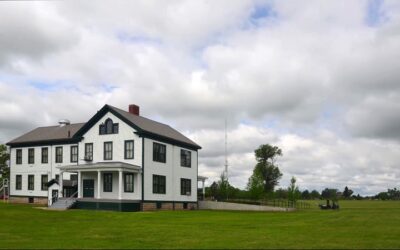The Nebraska Game and Parks Commission (NGPC) and History Nebraska (HN) have long cooperated to interpret and preserve the historical archeological remains of Fort Atkinson State Historical Park. History Nebraska has been excavating at Fort Atkinson well before the NGPC purchased the land in 1963. Once the property was state-owned, the pace of excavations continued at a breakneck speed until 1971. Those early years of excavation not only allowed portions of the barrack quadrangle to be faithfully reconstructed, it cemented a partnership between the two agencies that continues to this day.
Last October, the NGPC and HN held a community dig at the fort where volunteers and HN staff tested Feature 173, which was thought to be the band or schoolhouse (Fig. 1). Prior to the dig, NGPC staff had mowed and watered the location to facilitate easier digging and screening. Considerable material was recovered, including some standard military items like a uniform button and musket ball (Fig. 2 and 3). What was unexpecting discovered was the variety of colorful ceramic sherds and a piece of women’s jewelry (Fig. 4 and 5). It was concluded that the large scatter of artifacts excavated could represent more than one building. It is still possible that the band or schoolhouse was in this location, but it is clear from the amount of fancy domestic ceramics and other artifacts that an officer and probably his wife lived at the location.
This year, the work continues. The NGPC has installed drainage lines to protect the log barracks from water to ensure the structures remain in place for future generations. Previously, HN archeologists had conferred with the park about the project but something unexpected turned up during construction. That is not unusual, as the intense level of activity during the fort’s occupation has left archeological evidence all over the park. While digging the trench for the drainage line an ash deposit with associated artifacts was encountered including a pocket knife (Fig. 6). By the the time HN staff arrived, the drainage pipe was in place making excavation challenging (Fig. 7). However, it became clear that the ash deposit was not contained in a pit and was most likely tossed onto the ground. A small secured door, called a sally port, would have led outside the northeast corner of the barracks quadrangle at this spot.
Another affected location by the drainage line was the remains of a brick sidewalk that was discovered in 1970. After an inspection, only three bricks were found in place from the sidewalk (Fig. 8). Sometime between 1970 and 2023, the feature must have been removed. In the end, the drainage route through the area was further tested and nothing significant was found.
The projects completed at Fort Atkinson show History Nebraska’s and the Nebraska Game and Parks Commission’s dedication to working together to give proper care to the archeological record of the fort while also providing the best experience for visitors. This partnership was been in place for 60 years and will continue long into the future. Stay tuned for future updates from investigations at a suspected blacksmith building from the 2023 Community Dig this fall!
Further information
Gayle F. Carlson, 1997 Archeological Surveying, Testing, and Remote Sensing, at Fort Atkinson. Nebraska State Historical Society prepared for the Nebraska Game and Parks Commission.
Marvin F. Kivett, “Excavations at Fort Atkinson, Nebraska: A Preliminary Report,” Nebraska History 40 (1959): 39-66
Sally A. Johnson, “Fort Atkinson at Council Bluffs,” Nebraska History 38 (1957): 229-236
You can also visit:
You can also view a Brown Bag Lecture on Fort Atkinson by History Nebraska Archeologist Nolan Johnson HERE.












